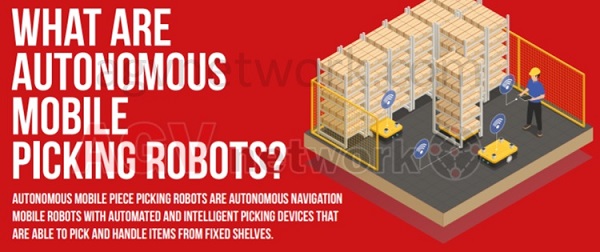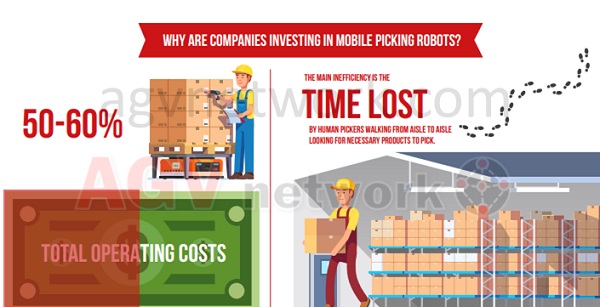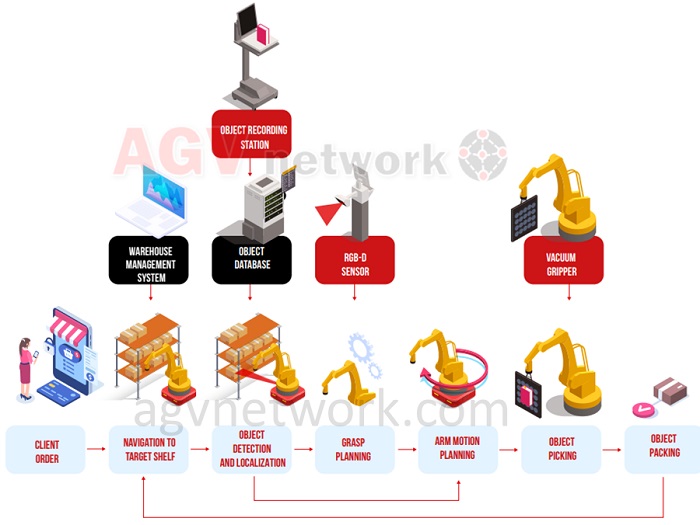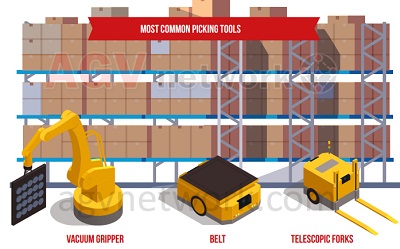What are Autonomous Mobile Picking Robots? It' time to replace hands
Autonomous Mobile piece picking robots are autonomous navigation mobile robots with automated and intelligent picking devices that are able to pick and handle items from fixed shelves. These robots represent one of the most interesting applications of AMR.
Mobile automated picking systems are widely used in markets requiring agile and dynamic supply chain operations such e-commerce fulfilment centres and smart warehouses.
Thousands of daily orders paired with the thousands of different small products (SKUs) makes the warehouse environment chaotic and complicates daily operations.

On top of complex orders, customers expect their purchases to be fulfilled within next day the latest, which requires a flexible and scalable warehouse, especially on special days, sale days, and other high volume holidays (daily demands are fivefold on Black Friday and Cyber Monday!).
Because of the competition and customer order complexity, warehouse managers began automating their transportation warehouse operations to become faster and more productive.
When they dug deeper, they found out that the order picking operation – the process of removing items from storage to meet a specific demand – is the pain point of warehouse operations. It stands for 50-60% of the total operating costs of manually operated traditional warehouses.
The main inefficiency is the time lost by human pickers walking from aisle to aisle looking for necessary products to pick. This travelling activity takes around 55% of human picker’s total time.
A key automation opportunity for the warehouses is mobile robots. These automation systems were developed to eliminate the unproductive travelling time of human pickers.

In the 2000s, autonomous picking robots that have arms for picking, onboard intelligence, and more flexibility in navigation began to travel in the warehouse environment. They can automate the whole order picking operation on their own in a robots-to-goods or goods-to-person context.
However, there are still several questions that need answers concerning the operations of automated mobile picking robots.

Click here to discover the mobile picking robots manufacturers
Where are autonomous mobile picking robots used?
These robots are mostly used in order picking operations in warehouses, especially in the e-commerce context.
However, there are other use cases in warehouses such as order sorting, replenishment, and inventory counting.
They are also used out of the warehouse context in industrial needs such as strawberry picking in agriculture or aiding manufacturing operations in factories.
What are the advantages of adopting autonomous picking robots in a warehouse?
Mobile Robots offer great benefits if they are suitable for your operations.

As aforementioned, they remove at least 50% of total operating cost since they completely automate the operations allowing human employees to focus on non-automated warehouse issues.
They can sort up to thousands of parcels in an hour and could reduce human labour costs by upwards of 70%.
At the end of the day, mobile robots are significantly cheaper than human workers. Once you buy them, you will only have an ongoing maintenance cost and power cost to charge them.
They are reliable as they do not make errors and can operate 24/7.
Mobile robots can collaborate with human operators and perform tedious and annoying tasks leaving human colleagues free to perform more complicated and valued tasks.
More and more companies are facing increasing staff shortages. If your demand goes up, the only thing you need to do is to scale up your warehouse inventory and rent or buy more robots..
They do not require training and they start working as soon as they are in the warehouse with an up to date map.
How do autonomous mobile picking robots coordinate with each other and humans?
To allocate the robot’s automated tasks and optimise their navigation through the facility, while preventing deadlocks or conflicts among robots, they need to be coordinated by a Management Software.
The software is responsible for fleet, traffic management, and other various logistics functions, including order fulfilment.
Mobile Robot Management Systems are crucial and make the difference in terms of value added for the customer.
The management system should be integrated with and existing Warehouse Management System (WMS) or a Manufacturing Execution System (MES).
In most cases, it is necessary to create a standard Application Programming Interface (API), for capturing and exchanging tasks automatically with the autonomous picking robots.
The management system can be further customized to meet specific requirements related to traffic rules, prioritizations, presenting performance data, and optimizing battery consumption.
How do autonomous mobile picking robots navigate?
After the task distribution, robots start to plan their path to the next target shelf, generally without requiring any information from external sources as they have onboard intelligence.
Autonomous Picking Robots typically perform Natural Navigation using several sensors such as Light Detection and Ranging (LiDAR) scanners with simultaneous localisation and mapping (SLAM) algorithms.
The robot sends laser beams via LiDAR to measure the distances of objects around it to extract the environment map and its position in the environment with the help of SLAM.
Another common method is the inertial quick response (QR) code. The mobile robot uses inertial devices to locate its position and move in the warehouse environment. It then uses the corners of the QR code on the ground to correct the output of inertial devices.
How do autonomous mobile picking robots pick?
Once they accurately navigate to the shelf, the robot is ready to start picking.
Mobile picking robots have compartments or tote bins on them, and they put the products they pick into these areas.
Once they reach their capacity, they return to the packing area to unload what they have picked or collected.
Below is a general framework of how mobile picking robots operate.

First, information about products that are subjected to picking operation should be uploaded to the management software database of the robots.
The mobile robot management system will assign the mission to a given robot.
Once a robot is assigned a task, it navigates to the product’s location and detects the product with the help of cameras such as an RGB-D. The robot then does the picking via a vacuum gripper or other infrastructure.
-
Mobile Picking Robots with Vacuum Gripper
This version is the most common currently in operation. The robot has a picking arm attached with a suction unit (vacuum gripper/s).
The arm reaches to the product or box; the suction unit vacuums it and takes it on top of the robot.
If the robot has a capacity for multiple products, the robot continues to do several more pickings, otherwise, it goes to unload the product.
When configured correctly, vacuum grippers can allow for very short cycle times. They perform High-speed pick-and-place.
Vacuum grippers are the best option for wide flat objects (such shoes carton boxes) or delicate handling as hardly any force is applied to the surface of the objects.
-
Picking via Belt
In this version, the robot has a conveyor-belt like a belt on top of it. These robots are mainly used in sorting operation.
They pick the boxes from a conveyor belt, and they roll it into a hole or a bin after navigating to the correct location.
-
Picking via Fork
The robot here picks tote bins with a telescopic fork from shelves and carry it to the packing workstations for human pickers to do the picking in a goods-to-person context just like Kiva shelf-carrying robots.
There are also studies on the utility and efficiency of two-armed mobile robots. These robots could be important as they can hold the products just like a two-handed human picker.
To conclude, even though there are many ways robots can do their picking, robot picking capacity is still inferior to human picking in terms of speed and accuracy. For this reason, researchers and practitioners focus on investigating new technologies. A great example of this is the recent content, the Amazon Picking Challenge.

How much do autonomous mobile picking robots cost?
An autonomous mobile picking robot costs $50000-$60000.
To lower the initial investment barrier, manufacturers of mobile picking robots changed their pricing strategy into robots as a service
The main advantage of this strategy from the warehouse decision-maker point of view is that instead of paying the full price and taking the technological risks of the robots, the user pays for given KPIs such “pay per pick”.

Rather than buying a whole fleet of robots, customers simply pay a monthly service fee based on the number of picks the company might need the robots for.
Robotic Pay per pick costs vary from $0.05 to $0.25 compared to traditional $1 per pick for companies that do not use robots. You can obviously see the economic benefit in the Pay per Pick automated solution.
Mobile picking robots can also be leased at variable monthly prices between $2000 and $5000.
RaaS and lease options typically include the mobile robot maintenance cost.
What should I plan if I decided to buy an autonomous mobile picking robot?
Define a good Change Management Strategy
First thing’s first, you need change management. Some companies even form teams to handle human worker reaction (they will fear they are going to be fired), human worker new task clarification & distribution, and training for the upcoming operation.
Robot Friendly Layout Optimization
You might need to alter your warehouse layout. These robots can only pick at most several kilograms of a rigid product or a box if they have multiple products carrying capacity. Thus, products that are beyond that scope might be left out of their operational area to increase the efficiency and they could be picked through another solution.
You will probably need to plan how to re-organise the pick locations in your shelves.
Picking functions of these robots still have some limitations. So, these robots need very structured pick locations, otherwise it may take too long for them to pick the correct product or it may even fail to pick.
You need to plan simulation scenarios for your warehouse to estimate the system performance and optimal fleet size.
Further from simulations, you might need to initiate a pilot study in a pilot location with a low number of robots before completely handing your picking operation to mobile picking robot fleet.
Other subjects such as;
- KPI identification for your new operations (robot utilisation, average task completion time, task allocation and path planning computation time, number of deadlocks/conflicts).
- Type of coordination/communication (merging the software of robots with warehouse management system / centralised or distributed robot coordination).
- Path planning (algorithms for shortest paths without conflicting other robots or human workers).
- Maintenance strategy (action plan in case of a robot failure during operations + routine maintenance requirements).
- Mobile Robot Battery management (when to charge? where to charge? how to charge? battery swapping or charging?)
will probably be provided by the mobile picking robot manufacturing company so you might start looking for improvement in these areas after the implementation.
This article has been written by Alp Yildirim in collaboration with AGV Network team


